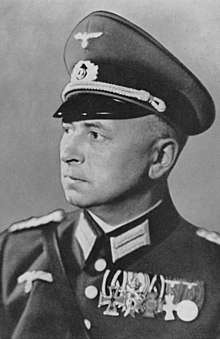Eduard Wagner
Eduard Wagner (1 April 1894 – 23 July 1944) was a general in the Army of Nazi Germany who served as quartermaster-general in World War II. He had the overall responsibility for security in the Army Group Rear Areas, and thus bore responsibility for the war crimes committed by the rear-security units in the occupied areas under the army's jurisdiction.
Eduard Wagner | |
|---|---|
 Wagner in 1939 | |
| Born | 1 April 1894 Kirchenlamitz, Bavaria, Germany |
| Died | 23 July 1944 (aged 50) Zossen, Brandenburg, Prussia, Germany |
| Allegiance | |
| Service/ | Army |
| Rank | General of the Artillery |
| Commands held | Quartermaster-General of the German Army |
| Battles/wars |
|
He was born in Kirchenlamitz, Upper Franconia. After service in World War I he was a member of the Reichswehr. In World War II he served as the quartermaster-general from 1941 to 1944 and was promoted to General der Artillerie on 1 August 1943.
On 24 July 1939 he drew up regulations that allowed German soldiers to take hostages from civilian population and execute them as response to resistance.[1] He personally welcomed the idea of future invasion of Poland, writing that he looked to it "gladly".[2] He had a central role in the death sentences for ten Polish prisoners taken in the Defense of the Polish Post Office in Danzig. In May 1941, he drew up the regulations with Reinhard Heydrich that ensured that the Army and Einsatzgruppen would co-operate in murdering Soviet Jews.[3] On the Eastern Front he had a role in ensuring that suitable winter clothing was supplied to the German forces and on 27 November 1941 he reported that "We are at the end of our resources in both personnel and material. We are about to be confronted with the dangers of deep winter."
In the summer of 1942, before his visit to inspect the 6th Army during the Battle of Stalingrad, he informed Hitler of the "lack of sources of fuel." By that time, "all the generals avoided contradicting Hitler" as "all feared the hysterical outbursts of this lofty dictator."[4]
After the war, Otto Bräutigam of the Reich Ministry for the Occupied Eastern Territories claimed in his book that in February 1943 he had the opportunity to read a personal report by Wagner regarding a discussion with Heinrich Himmler, in which Himmler had expressed the intention to exterminate about 80% of the populations of France and England by special forces of the SD after the German victory.[5]
He became a conspirator against Adolf Hitler. When Claus von Stauffenberg sought approval for an assassination attempt on 15 July 1944, he was cited as being definite that the assassination of Hitler should only be attempted if Heinrich Himmler was also present. On 20 July 1944, he arranged the airplane that flew Stauffenberg from Rastenburg back to Berlin after the bomb believed to have killed Hitler had exploded.[6]
After the failure of the coup attempt, he feared that his arrest by the Gestapo was imminent and that he might be forced to implicate other plotters. He committed suicide by shooting himself in the head at noon on 23 July 1944.
References
- Megargee, Geoffrey P. (2006). War of Annihilation: Combat and Genocide on the Eastern Front 1941. Rowman & Littlefield. p. 13. ISBN 0-7425-4481-8.
- Weinberg, Gerhard L. (1995). Germany, Hitler, and World War II: Essays in Modern German and World History. Cambridge University Press. p. 14. ISBN 0-521-47407-8.
- Hillgruber, Andreas (1989). "War in the East and the Extermination of the Jews". In Marrus, Michael (ed.). The Nazi Holocaust Part 3, The 'Final Solution': The Implementation of Mass Murder. 1. Westpoint, CT: Mecler. pp. 94–96. ISBN 0-88736-255-9.
- Adam, Wilhelm; Ruhle, Otto (2015). With Paulus at Stalingrad. Translated by Tony Le Tissier. Pen and Sword Books Ltd. p. 85. ISBN 9781473833869.
- Bräutigam, Otto (1968). So hat es sich zugetragen... Germany: Holzner Verlag. p. 590.
- Fest, Joachim (1994). Plotting Hitler's Death: The German Resistance to Hitler, 1933-1945. Weidenfeld & Nicolson. ISBN 0-297-81774-4.